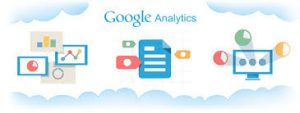Analytics Tools provide associate insight into the performance of your web site, visitors’ behavior, and information flow. These tools are cheap and simple to use. Sometimes, they’re even free.
Google Analytics
Google Analytics is a premium analytic tool that provides a detailed statistics of the web traffic. It is used by more than 60% of website owners.

Google analytics helps you to track and measure visitors, traffic sources, goals, conversion, and other metrics (as shown in the above image). It basically generates reports on:
- Audience Analysis
- Acquisition Analysis
- Behavior Analysis
- Conversion Analysis
Let us discuss each one of them in detail.
Audience Analysis
As the name suggests, audience analysis gives you an overview of the audience who visit your site along with their session history, page-views, bounce rate, etc. You can trace the new likewise because the returning users at the side of their geographical locations. You’ll be able to track:
- The age and gender of your audience below Demographics.
- The affinity reach and market segmentation under Interests.
- Language and location under Geo.
- New and returning visitors, their frequency, and engagement under Behavior.
- Browsers, Operating systems, and network of your audience in Technology.
- Mobile device info under Mobile.
- Custom variable report under Custom. This report shows the activity by custom modules that you created to capture the selections.
Acquisition Analysis
Acquisition analysis is administered to seek out the sources from wherever your net traffic originates. Victimization acquisition analysis, you can:
- Capture traffic from all channels, specific source/medium, and from referrals.
- Trace traffic from AdWords (paid search).
- See traffic from search engines. Here, you’ll be able to see Queries, triggered landing pages, and geographical outline.
- Track social media traffic. It helps you to identify networks wherever your users are engaged. You’ll see referrals from wherever your traffic originates. You’ll even have a read of your hub activity, bookmarking sites follow-up, etc. within the same tab, you’ll have a glance at your endorsements in details. It helps you measure the impact of social media on your website.
- See which plug-ins gave you traffic.
- Have a look at all the campaigns you built throughout your website with detailed statistics of paid/organic keywords and the cost incurred on it.
Behavior Analysis
Behavior analysis monitors users’ activities on a website. You can notice activity knowledge underneath the subsequent four segments:
- Website Content: It shows what percentage pages were viewed. You’ll see the elaborated interaction of information across all pages or in segments like content drill-down, landing pages, and exit pages. Content drill-down is breaking apart of information into sub-folders. Landing page is that the page wherever the user lands, and exit page is wherever the user exits your website. You’ll live the activity flow in terms of content.
- Site Speed: Here, you can capture page load time, execution speed, and performance data. You can see how quickly the browser can parse through the page. Further, you’ll be able to live page timings, user timings, and find speed suggestion. It helps you to understand wherever you’re insulating material.
- Website Search: It provides you a full image of however the users search across your site, what they usually explore for, and the way they attain a specific landing page. you’ll be able to analyze what they seek for before landing on your web site.
Conversion Analysis
Conversion could be a goal completion or a dealings by a user on your web site. As an example, download, checkout, buy, etc.
- Goals – Metrics that live a profitable activity that you simply wish the user to finish. You’ll set them to trace the actions. Each time a goal is achieved, a conversion is additional to your information. You’ll be able to observe goal completion, value, reverse path, and goal flow.
- E-commerce – You can set e-commerce tracking to know what the users buy from your website. It helps you to find product performance, sale performance, transactions, and purchase time. Based on these information, you’ll be able to analyze what are often useful and what can incur you loss.
- Multi-channel funnels – Multi-channel funnels or MCF reports the supply of conversion; what roles the web site plays, referrals’ role therein conversion; and what all slabs did once users tolerate landing page to conversion. As an example, a user explore for a question on Google search page, he visited the web site, however failed to convert. Later on, he directly typewritten your web site name and created a buying deal, of these activities are often copied on MCF.
- Attribution – Attribution modeling credits sales and conversions to touch points in conversion tracking. It lets you decide what platforms or strategy or module is the best for your business. Suppose an individual visited your web site through AdWords ad and created no purchase. A month later, he visits via a social platform and once more doesn’t get. Third time, he visited directly and regenerate.











COOLSEO
July 8, 2017 at 2:24 pm
We are a group of volunteers and opening a new scheme in our community. Your web site provided us with valuable information to work on. You have done an impressive job and our entire community will be grateful to you.